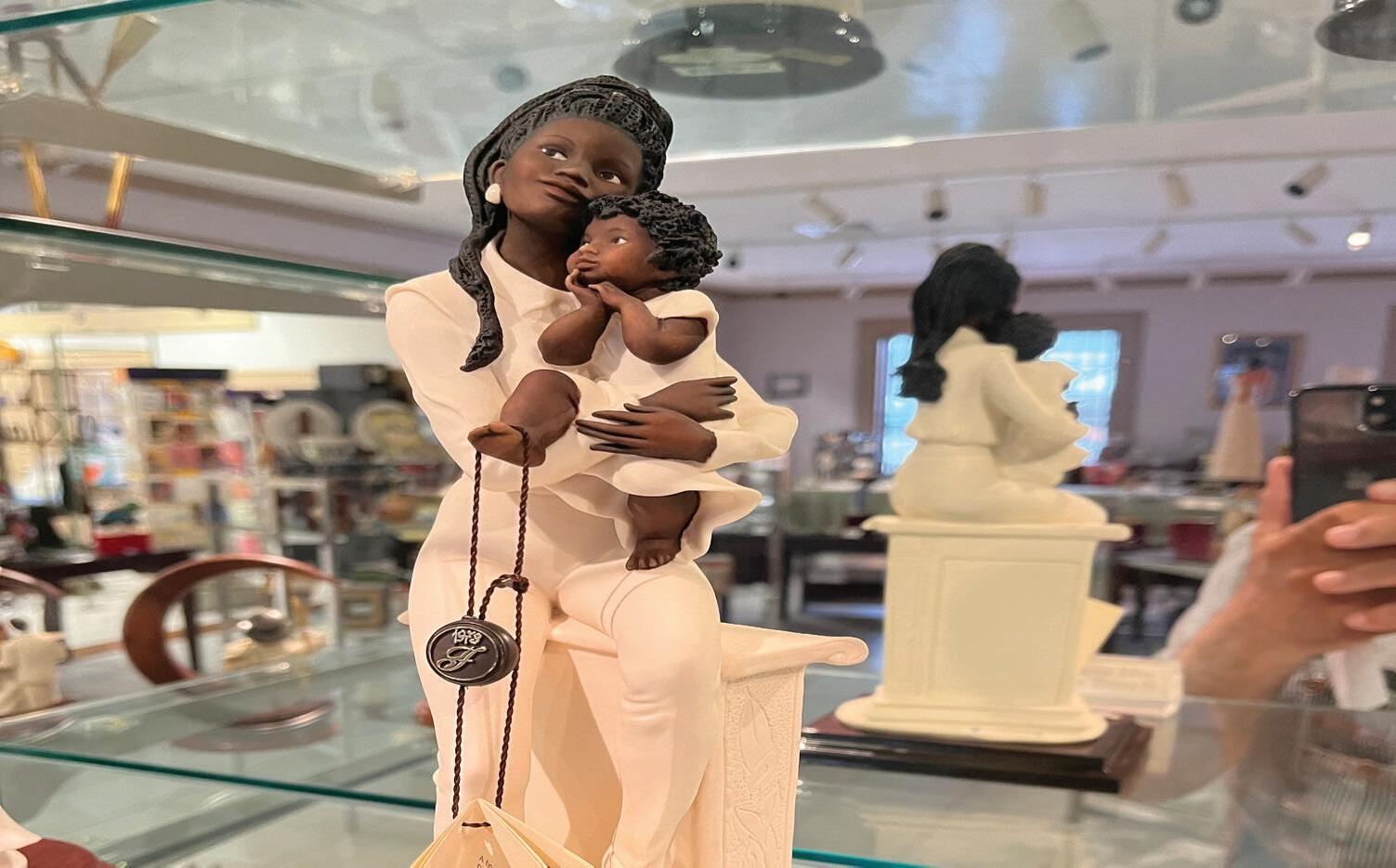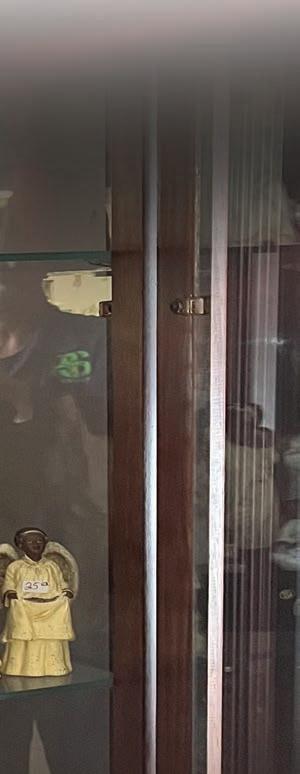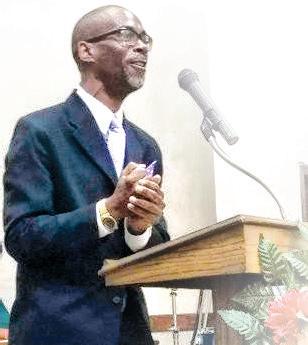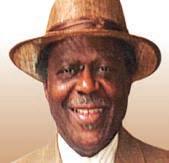








Success is one of the greatest causes of failure.
- Roy Douglas Malonson


By: SH-FBISD News
e names of new FBISD campuses were approved at the district’s Monday night business meeting with plans for one of the schools to bear the name of a legendary high school coach who recently passed away.
e newly constructed campus for Blue RidgeBriargate Elementary School will be named a er George Bush High School Head Football Coach and former NFL player Allen Aldridge Jr. who passed away suddenly in September at the age of 52.
His family was present at the board meeting and said the beloved coach would probably blush to see his name on a school.
By: Chloé Richards
In Houston’s ird Ward, Fi h Ward, and Acres Homes communities, multi-story townhouses stand next to century-old homes, and longtime residents navigate new realities in the places they have called home for generations. While developers say they’re creating a ordable housing, these “upgrades” come at a cost, the slow disappearance of historic Black
communities that have shaped Houston’s culture for generations.
Houston’s ird Ward, Fi h Ward, and Acres Homes have been pillars of Black history, culture, and community for decades. But with rising property values, rapid new developments, and shi ing demo- entri cation on .
“He would be happy, but he might have hidden his face,” upon receiving such recognition, the coach’s mother Cleotha Aldridge said.
His wife Tajuana agreed, “ is is not something he would ever have asked for because he was a very laid-back person, but he would be so proud and excited about this.”



Bobby Mills, Ph.D.








With some of his Presidential cabinet selections, especially Matt Gates, Trump is daring the GOP to initiate showdown time. Personal privilege Presidential power versus Senatorial advice and consent con rmation power is only a test. Sadly, accountability is an obsolete concept among most Republicans because the only quali cation for any governmental position in the Trump Administration is to be White, not intellectual, have no administrative experience and competence, nor loyalty to the tenets of the constitution. What a shame! Additionally, Wall Street is destined to nd out that life is about more than tax cuts for the rich, the famous, and the well-connected. Life is about commitment to civil decency and human interdependence because an individual is not


an island. Trump is boldly transparent, without the desire for civil accountability, and he has no shame in his ungodly game. us, Trump is assembling an antimulti-cultural democratic system coalition based upon conspiratorial Autocratic thinking, anti-democracy tenets, and White Privilege, something for nothing. e ungodly money train has pulled out of the station, and if you are willing to lie, steal, and disregard the Preamble and the U. S. Constitution, get on board. However, America spiritually comprehends this: individuals, as well as nationstates, cannot circumvent the spiritual, moral order of God’s Will because it is written: “For a child will be born to us, a son will be given to us: And the government will rest on His shoulders; And His name will be called Wonderful, Counselor, Mighty God, Eternal Father, Prince of Peace.” (Isaiah 9: 6). Christian Right Evangelicals, the GOP, Fox “FAKE” News, White Nationalists, and some spiritually
By: Rachel Thompson
People may say, “I’m not political,” or “I don’t discuss politics,” but the fact of the matter is that we live politics daily. Now is not the time for passive politics just because the presidential election is over. Now is the time to stay engaged because it is state and local government that effects our daily lives the most. While the average Texan is currently focused on the holiday season, many legislators and lobbyists are planning to shake things up during this 89th Texas Legislative session which starts January 14, 2025, and runs through June 2, 2025. Legislators began submitting bills November 12th that may impact education, immigration, health, public safety, reproductive rights, property taxes, etc. erefore, it is important to know who our state representatives are and how to reach them. While Republicans have the majority in both chambers, it is important to remember Henry Kissinger’s statement, “Amer-
ica has no permanent friends, no permanent enemies, only permanent interests.” Using that same logic, we each have to determine our individual permanent interests, and express that interest to our elected o cials regardless of their party a liation. e most vulnerable Texans are children. ey cannot vote but experience the outcomes at school daily. During the last legislative session, the Texas Education Agency was directed to develop instructional materials for statewide use as a result of House Bill (HB) 1605. Bluebonnet Learning is what they came up with for kindergarten through h graders. e State Board of Education (SBOE) recently approved the curriculum that includes biblical references across grade levels. Children who are not Christians will still be expected to demonstrate mastery of the material. Currently, the curriculum is optional and pro- ea more at aframnews.com
Po itics on .

“We Africans in America have been socially engineered to reject our past, and far too many of us live in a state of suspended animation. We deny the historical realities confronting us daily. Too many of us mistakenly believe that the past has no bearing on the present and is unrelated to the future. Thus, we have been conditioned to live our lives disconnected from cultural values, principles, and ideals - essential for peaceful living.”
- Anthony T. Browder
graphics, these neighborhoods are changing fast, o en at the expense of their historic landmarks and residents.
ird Ward: “Black River Oaks”
ird Ward has long been regarded as the “Heart of Black Houston,” a neighborhood lled with places that are signi cant to Houston’s Black identity. Home to Texas Southern University (TSU), Houston’s only HBCU, ird Ward has nurtured generations of Black leaders and artists, with its cultural and academic inuence extending far beyond Houston. Community landmarks, like Unity National Bank—the only Black-owned bank in Texas—have provided economic empowerment, while places like Wheeler Avenue Baptist Church, ird Ward Multi-Service Center, Emancipation Park, and Project Row Houses serve as community landmarks.
Once overwhelmingly Black, the ird Ward’s African American population has drastically declined, making up just 45% of the area today, down from 71% in 2010, according to the Houston Chronicle. Rising property values and increasing development have changed the landscape of the ird Ward, with luxury apartments and high-rise buildings replacing older homes and small businesses. e closure of institutions like the historic Houston Negro Hospital, later known
as Riverside General Hospital, which treated Black patients independently until its closure in 2015, depicts the changes occurring in this neighborhood. Despite e orts from community groups to preserve what remains, gentrication continues to push out Black residents and threaten the history, spirit, and pride that de ne the ird Ward. Fi h Ward: “ e Nickle” Just northeast of downtown, Fi h Ward, known as “ e Nickel,” has a history rooted in resilience and vibrant Black culture. For decades, it served as a major Black business and entertainment hub, with Lyons Avenue lined with grocery stores, barbershops, churches, and funeral homes. is was the neighborhood where prominent gures such as Congresswoman Barbara Jordan, civil rights activist Mickey Leland, and heavyweight champion George Foreman grew up, and it fostered a strong sense of community and pride.
But today, the Fi h Ward is one of Houston’s most economically depressed neighborhoods, facing population decline and gentri cation pressures. New luxury developments are appearing alongside longstanding family homes, raising property values and creating concerns of displacement. In 2014, despite objections from local residents, the original Phillis Wheatley High School building, a signi cant
landmark, was torn down. e school, once a centerpiece of Black education in the Fi h Ward, saw a signi cant shi in demographics and enrollment, a re ection of the changes a ecting the neighborhood. ough many new projects promise a ordable options, residents question whether they can maintain the history and integrity of the Fi h Ward amid the rush of development.
Acres Homes: “44”
Located in North Houston, Acres Homes has a unique legacy among the city’s Black neighborhoods. Known for its land sold by the acre, this community was originally developed a er World War I to provide a ordable housing to Black families seeking homeownership opportunities. Acres Homes has produced
Acres Homes has produced notable gures like rapper Slim ug, former Houston mayor Sylvester Turner, and rapper Paul Wall. While the ird and Fi h
Wards are closer to Houston’s downtown “inside the loop,” Acres Homes proudly represents the northside of Houston.
Over the years, the neighborhood has seen a shi , with a growing Latino population and the construction of multistory townhomes, which contrast sharply with the traditional one-story homes. Developers o en argue that they’re o ering a ordable housing options, but the price tags of new developments have raised doubts among locals. With the area’s historic signi cance as a haven for Black homeowners, the pressure of development threatens the continuity of Acres Homes’ legacy.
e Larger Picture: What Gentri cation Means for Houston’s Historic Black
values, it’s a direct threat to cultural heritage, community cohesion, and the sense of belonging that has long de ned these neighborhoods. For Black residents in the ird Ward, Fi h Ward, and Acres Homes, gentri cation o en brings the possibility of displacement, the deletion of neighborhood landmarks, and the loss of spaces that have o ered community, identity, and pride for generations.
e stakes are high for Houston’s Black communities as gentri cation accelerates. Each new development project represents a choice— whether to prioritize pro t or protect the legacy and resilience of these neighborhoods. For the generations to come, the preservation of these cultural places will determine
cultural places will determine whether Houston remains a city that honors its diverse history or loses sight of the communities that built it.

Houston’s Historic Black Neighborhoods Gentri cation in Houston’s Black communities represents more than just new housing projects or increased property





Taken from justiceatthegate.com
Our Negro citizens have participated actively in the economic and social advances launched by this Administration, including fair labor standards, social security bene ts, health protection, work relief projects, decent housing, aid to education, and the rehabilitation of low-income farm families. †
We have aided more than half a million Negro youths in vocational training, education, and employment. We shall continue to strive for complete legislative safeguards against discrimination in government service and bene ts and in the national defense forces. We pledge to uphold due process and the equal protection of the laws for every citizen, regardless of race, creed or color. ††
We pledge that our American citizens of Negro descent shall be given a square deal in the economic and political life of this nation. Discrimination in the civil service, the army, navy, and all other branches of the government must cease. To enjoy the full benefits of life, liberty and pursuit of happiness, universal suffrage must be made effective for the Negro citizen. Mob violence shocks the conscience of the nation and legislation to curb this evil should be enacted.
Politics Cont.
† e President at this time was Democrat Franklin Delano Roosevelt. In an unusual move for Democrats, Roosevelt in 1932 had invited black Americans to vote Democratic in the elections. However, Roosevelt understood his Party, and made only subtle overtures to black Americans while avoiding any overt civil rights promises. While Roosevelt created what became known as his “Black Cabinet” to advise him on issues of importance to black Americans, and although he did begin to include black Americans in economic programs, he did little for civil rights and in fact did not even introduce a single bill to protect or promote civil rights.
†† It was under Roosevelt that Democrats for the rst time placed language in their platform calling for an end to racial discrimination; yet despite the new language in their platform, Democrats in Congress still killed every civil rights bill introduced in that era.

The 1940 Republican Platform called for a bill to end mob violence which had become common. The Democrats began to talk of ending discrimination, but still killed every civil rights bill introduced in that era.
vides a $60 per student incentive to adopt it. It is very likely that this 89th session could result in a similar curriculum for secondary students, and/or make the Bluebonnet Learning curriculum mandatory instead of optional. Parents and teachers, who are also constituents, need to identify their personal interests and contact their state representatives to express their position regardless of party a liation. Vouchers will also be a topic that will make a comeback. ere were four special sessions between May 2023 and December 2023 in attempts to get school vouchers passed. Again, constituents will need to identify their personal interests concerning sending public dollars to private schools and make their voices heard. Needless to say, vouchers will a ect rural districts and high poverty school districts the most if passed by creating a de cit for those districts. e $60 per student may become more enticing for school districts that struggle nancially. e bible and limited educational resources have been used historically to marginalize and control groups of people, especially those that were enslaved here in America. Descendants of enslaved Americans
Americans
largely attend public schools. is could be seen as a retro reboot of oppression. During the last session, lawmakers also passed Senate Bill (SB) 17, which eliminated public colleges and universities from having diversity, equity and inclusion (DEI) o ces or performing those functions. At a recent policy summit hosted by the Texas Public Policy Foundation, Sen. Paul Bettencourt, RHouston, said “Texas is far from done,” about SB 17. Bettencourt serves on the Senate Education Committee. Rep. John Bucy, D-Austin, who serves on the House Higher Education Committee, told the Austin Statesman that SB 17 and SB 18 are “major steps backwards” that “micromanage” institutions to their detriment. Next session, he hopes to repeal the anti-DEI law. College students, who are voters, along with parents, professors, and others need to identify their personal interests and contact their state representatives to express their position, too. e Texas legislature is composed of 15 seats in the Texas Senate and the 150 seats in House of Representatives. Use https://wrm. capitol.texas.gov/home to nd out who represents you in Texas and on the State Board of Education (SBOE).



By: Chloé Richards
In Houston’s ird Ward, Fi h Ward, and Acres Homes communities, multi-story townhouses stand next to century-old homes, and longtime residents navigate new realities in the places they have called home for generations. While developers say they’re creating a ordable housing, these “upgrades” come at a cost, the slow disappearance of historic Black communities that have shaped Houston’s culture for generations.
Houston’s ird Ward, Fi h Ward, and Acres Homes have been pillars of Black history, culture, and community for decades. But with rising property values, rapid new developments, and shi ing demographics, these neighborhoods are changing
fast, o en at the expense of their historic landmarks and residents.
ird Ward: “Black River Oaks”
ird Ward has long been regarded as the “Heart of Black Houston,” a neighborhood lled with places that are signi cant to Houston’s Black identity. Home to Texas Southern University (TSU), Houston’s only HBCU, ird Ward has nurtured generations of Black leaders and artists, with its cultural and academic in uence extending far beyond Houston. Community landmarks, like Unity National Bank—the only Black-owned bank in Texas—have provided economic empowerment, while places like Wheeler Avenue
entri cation pg. 3
La historia se repite en tiempo real, invirtiendo el reloj. - Roy Douglas Malonson

By: SH-FBISD News
e names of new FBISD campuses were approved at the district’s Monday night business meeting with plans for one of the schools to bear the name of a legendary high school coach who recently passed away. e newly constructed campus for Blue RidgeBriargate Elementary School will be named a er George Bush High School Head Football Coach and former NFL player Allen Aldridge Jr. who passed away suddenly in September at the age of 52.
His family was present at the board meeting and said the beloved coach would probably blush to see his name on a school.
“He would be happy, but he might have hidden his face,” upon receiving such recognition, the coach’s mother
Cont. pg. 4
Oficina : 713-692-1892 Escritores Contribuyentes
Escritores Contribuyentes
10 a.m. a 4 p.m.
el Oficina : 713-692-1892
Family holds a special place during the holidays, serving as the anchor that ties together the warmth, joy, and meaning of this season. e holidays, whether celebrated with religious traditions, cultural customs, or simple family gatherings, are o en viewed as a time for togetherness and re ection. Here are several reasons why family is especially important during this time of year:
e holidays can stir a wide range of emotions. While they bring joy, they can also bring stress, loneliness, and sometimes grief. Family o ers a steady emotional foundation, providing comfort and reassurance. Being with loved ones allows people to share their highs and lows, easing the weight of any challenges or burdens that may arise, particularly as we re ect on the past year and anticipate the one ahead.
Holiday traditions, big or small, help create shared memories that families cherish for years. Whether it’s cooking a favorite meal together, decorating the house, or playing games by the re, these moments become milestones in a family’s story.
Repeated over the years, they form a sense of continuity and connection, passing down values, stories, and customs to younger generations.
e holidays o en remind us of the importance of belonging to something larger than ourselves. Family provides a sense of rootedness and identity, reinforcing the notion that we are part of a collective. It’s a time when the emphasis shi s from individualism to togetherness, where bonds are strengthened and the collective spirit nurtures a sense of belonging that transcends the holiday season.

Family is the rst place where we learn about giving— whether it’s through sharing gi s, acts of kindness, or the simple act of being present for one another. e holidays encourage expressions of gratitude and love, and family gatherings provide a perfect setting for those moments. e exchange of presents, shared meals, and thoughtful gestures all contribute to a deeper sense of appreciation for one another.
In the hustle and bustle of everyday life, it’s easy to get caught up in routines that pull families in di erent directions. e holidays o er a rare opportunity to slow down, re ect, and reconnect. For many, the holiday season is a chance to pause and appreciate the blessings of family, reassess what truly matters, and renew their commitment to nurturing those relationships in the year ahead.
Whether through laughter around the dinner table, sharing stories, or simply spending time together, the holidays serve as a unique opportunity to strengthen familial bonds. Family time during the holidays fosters unity and reminds everyone of their shared history, the importance of compassion, and the need for understanding and forgiveness.
Every family has its own unique set of traditions— whether it’s certain foods, speci c holiday rituals, or simply the way they celebrate together. ese traditions o er a sense of stability and continuity, creating rituals that bind family members together year a er year. rough these traditions, the holidays become more than just a series of days o from work; they become a living celebration of family, culture, and love.



entri cation
Cont.
Baptist Church, ird Ward Multi-Service Center, Emancipation Park, and Project Row Houses serve as community landmarks.
Once overwhelmingly Black, the ird Ward’s African American population has drastically declined, making up just 45% of the area today, down from 71% in 2010, according to the Houston Chronicle. Rising property values and increasing development have changed the landscape of the ird Ward, with luxury apartments and high-rise buildings replacing older homes and small businesses. e closure of institutions like the historic Houston Negro Hospital, later known as Riverside General Hospital, which treated Black patients independently until its closure in 2015, depicts the changes occurring in this neighborhood. Despite e orts from community groups to preserve what remains, gentri cation continues to push out Black residents and threaten the history, spirit, and pride that de ne the ird Ward.
Fi h Ward: “ e Nickle”
Just northeast of downtown, Fi h Ward, known as “ e Nickel,” has a history rooted in resilience and vibrant Black culture. For decades, it served as a major Black business and entertainment hub, with Lyons Avenue lined with grocery stores, barbershops, churches, and funeral homes. is was the neighborhood where prominent gures such as Congresswoman Barbara Jordan, civil rights activist Mickey Leland, and heavyweight champion George Foreman grew up, and it fostered a strong sense of community and pride.
But today, the Fi h Ward is one of Houston’s most economically depressed neighborhoods, facing population decline and gentri cation pressures. New luxury developments are appearing alongside long-standing family homes, raising property values and creating concerns of displacement. In 2014, despite objections from local residents, the original Phillis Wheatley High School building, a signi cant landmark, was torn down. e school, once a centerpiece of Black education in the Fi h Ward, saw a signi cant shi in demographics and enrollment, a re ection of the changes a ecting the neighborhood. ough many new
projects promise a ordable options, residents question whether they can maintain the history and integrity of the Fi h Ward amid the rush of development.
Acres Homes: “44”
Located in North Houston, Acres Homes has a unique legacy among the city’s Black neighborhoods. Known for its land sold by the acre, this community was originally developed a er World War I to provide a ordable housing to Black families seeking homeownership opportunities.
Acres Homes has produced notable gures like rapper Slim ug, former Houston mayor Sylvester Turner, and rapper Paul Wall. While the ird and Fi h Wards are closer to Houston’s downtown “inside the loop,” Acres Homes proudly represents the northside of Houston.
Over the years, the neighborhood has seen a shi , with a growing Latino population and the construction of multi-story townhomes, which contrast sharply with the traditional one-story homes. Developers o en argue that they’re o ering a ordable housing options, but the price tags of new developments have raised doubts among locals. With the area’s historic signi cance as a haven for Black homeowners, the pressure of development threatens the continuity of Acres Homes’ legacy.
e Larger Picture: What Gentrication Means for Houston’s Historic Black Neighborhoods
Gentri cation in Houston’s Black communities represents more than just new housing projects or increased property values, it’s a direct threat to cultural heritage, community cohesion, and the sense of belonging that has long de ned these neighborhoods. For Black residents in the ird Ward, Fi h Ward, and Acres Homes, gentrication o en brings the possibility of displacement, the deletion of neighborhood landmarks, and the loss of spaces that have o ered community, identity, and pride for generations.
e stakes are high for Houston’s Black communities as gentri cation accelerates. Each new development project represents a choice— whether to prioritize pro t or protect the legacy and resilience of these neighborhoods. For the genera-







Cleotha Aldridge said.
His wife Tajuana agreed, “ is is not something he would ever have asked for because he was a very laid-back person, but he would be so proud and excited about this.”
e school names were selected from a pool of more than 1,600 submissions that came in from the FBISD community.
e new campus for Mission Bend-Mission Glen Elementary will be named Mission Elementary School to commemorate the community’s spirit of empowerment through knowledge, inclusion and commitment to lifelong learning.
e specialty campus Ferndell Henry Center for Learning, which was named a er a FBISD high school biology teacher who served the district for almost 40 years, is being renovated and converted into an elementary school. It will become Ferndell Henry Elementary School.
“Before my dad passed away, I asked him if there was anything in life he would have done di erently,” Brian Henry said. “He answered, ‘no.’ He said he really enjoyed teaching.”
With Brian at the board meeting was his daughter -Ferndell’s granddaughter- Brynne Henry who teaches art at Sugar Land Middle School.
“It is nice to know that since my grandfather was a teacher in Fort Bend, I am continuing in his path,” she said. All three schools will open in August 2025
and are funded by the 2023 Bond.
Student Achievement Beginning of the Year Update
Also at the board meeting, the Department of School Leadership and Academic A airs congratulated Willowridge High School for its 2023 – 2024 academic progress and elimination of the School Improvement Comprehensive Support and Rating. Under the leadership of Principal Dr. Jennifer Roberts, the campus implemented evidence-based strategies to close academic gaps for students.
“ eir hard work, passion for kids, and commitment to excellence make us extremely proud of the good work they have done and continue to do for our Willowridge students who we expect to soar to even higher heights,” said FBISD Deputy Superintendent of Teaching and Learning Dr. Jaretha Jordan.
District leaders also outlined a detailed plan at the board meeting for other FBISD schools where leaders said they are rmly committed to seeing improved academic outcomes.
Aquatic Practice Facility
e board also voted to proceed with 2023 Bond plans to construct an aquatic practice facility to better serve students on the southeast side of the district. A total of $23 million was budgeted for the facility in June 2023 and any costs above that amount would come from 2014 and 2018 bond contingency funds.
FBISD Financial Rat-
In a public hearing held prior to the Board’s Regular Business meeting, the Fort Bend ISD Finance Department presented information showing the district has once again earned a rating of “A-Superior Achievement” for managing its nances in ways that directly and positively impact teaching and learning in the classroom.
e Texas Education Agency releases the ratings annually. FBISD has received a Superior Rating for the past two decades.
e district earned its yearly rating based on 21 di erent indicators, including its record of paying debts, managing expenses and allocating resources.
e TEA rating is called the School Financial Integrity Rating System of Texas or FIRST and is indicative of the district’s commitment to strong nancial management and transparency.
Additionally, the district’s external nancial auditor Whitley Penn recently issued an unquali ed opinion indicating Fort Bend ISD’s nancial statements are presented fairly in all material respects and in accordance with generally accepted accounting principles.
día de cacería incluye alojamiento y comida.




By: Bill King
As of last year, Houston’s tax increment reinvestment zones (TIRZs) had just under $1 billion in combined liabilities. e lion’s share of these liabilities is slightly over $80 million in bonds secured by the TIRZs, pledging their future property tax receipts. e balance of the liabilities is a potpourri of obligations, running from trade account payables to agreements to reimburse developers for improvements they have constructed.
To put the $800 mil-
lion of bonds issued by the TIRZs in some perspective, as of last year, the City of Houston only had about twice that amount ($1.723 billion) outstanding for all of its public improvement bonds. In other words, the TIRZs have issued a third of the total amount of bonds the City has borrowed for public infrastructure work. Just three of the TIRZs (Uptown, Midtown, and Main Street) account for over half the TIRZ bond debt. e recent research
from Baker Institute shows that the median income in these three TIRZs was at least 50% higher than the City’s median income.
e Uptown TIRZ alone accounts for 36% ($296 million) of the total bond debt. Included in that $296 million is $102 million issued by the Uptown TIRZ for a ordable housing. According to its audit, City Council has, incredibly, already authorized the Uptown TIRZ to issue an additional $232 mil-
lion in “a ordable housing” bonds.
It is important to understand that the TIRZs’ bonds are absolutely an obligation of the City of Houston and hence, its taxpayers. e only source of repayment of these bonds is future property tax receipts by the City, which will be transferred to the TIRZs so they can make the bond payments. Also, if any of the TIRZs are terminated, the City must assume their bond debt. at means the TIRZs
have tied up well over a billion dollars in future City property tax collections to service their bond debt. ose future property tax revenues will not be available to the City to pay for police, re, garbage pickup, etc. It will take almost $400 million of future property tax receipts just to service the bond debt run up by the Uptown TIRZ.
e City Council approved all of this debt. If the City had issued these bonds directly, voter ap-


proval would have been required. is is because the legislature, in its in nite wisdom, decided that bonds issued by the TIRZs would not require voter approval, creating a loophole cities can drive a Mack truck through. Of course, City Council could ask for voter approval even though the statute does not require it. I am not going to hold my breath waiting for that to happen.




















































































•
contact MC-vendors@lonestar.edu.




















